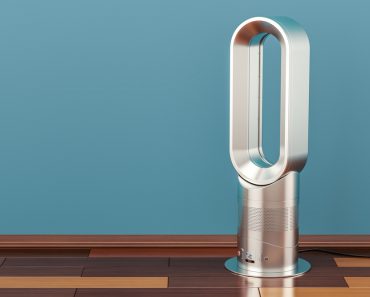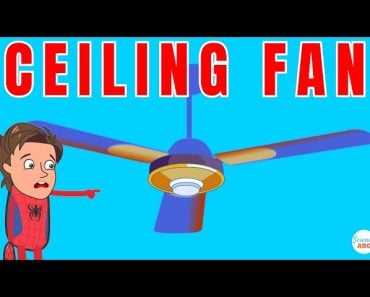Table of Contents (click to expand)
The main purpose of the blast of cold/hot air at the entrance of shopping malls is to prevent the infiltration of outside, unconditioned air into the conditioned space. By doing so, it reduces the electricity consumption of the building.
Every large public building, especially those whose doors must remain partially or completely open during operational hours, usually delivers a blast of hot or cold air at its entrance. You feel this blast of rushing air the moment you step inside the building through the doors.
If you’re stepping inside the building after spending hours in the scorching heat outside, the cold air blast hitting your body from above is one of the nicest feelings imaginable!

Similarly, there are also blower fans that blow hot air down from above the entrance.
As pleasant as the blast of cold/warm air feels when entering the building, have you ever wondered what the purpose is behind such air blowers? Are they there just to give the people entering the building a fleeting moment of fulfillment, or do they serve a much bigger, important purpose?
Of course, it’s the latter, but before we get to their real purpose, let’s quickly look at the underlying issue.
Recommended Video for you:
The Need For Energy-efficient Buildings
The construction and development of energy-efficient buildings has never been more important than it is today. With a rapidly growing global population and expeditious industrialization, there is unprecedented stress on our limited natural resources – resources that could be used to generate power – and those resources are being exhausted at an alarming rate. It’s obvious and necessary, therefore, that stringent steps should be taken to minimize the stress we place on these limited natural resources. Developing energy-efficient buildings is one of those steps.
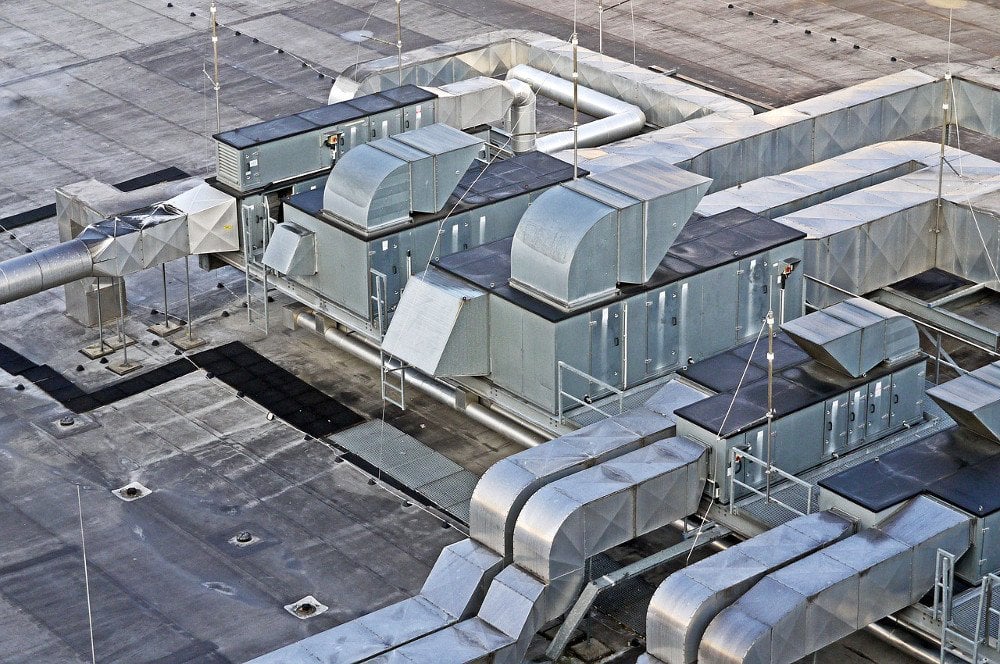
In large buildings and complexes, air conditioning is one of the largest contributors to the building’s total power consumption. Therefore, prior to installing large air-conditioning systems in these buildings, a great deal of effort goes into the analysis of the weather profile of their location. Depending on its design and how the building is going to be used, different parts of the building play smaller or larger roles in the total electricity consumption of the building.
It has been observed that the entrance(s) of these buildings play a significant part in their electricity consumption, especially in buildings that are frequently used, such as supermarkets, shipping centers etc.

It should be noted that the infiltration of outdoor air, i.e., the entry of outdoor air through the entrance and its subsequent mixing with the air inside the building, represents the largest energy loss for some buildings.
Enter air doors!
What Is An Air Door?
An air door, as the name suggests, is a device that prevents air or contaminants from moving from one space to another. According to the American Society of Heating, Refrigerating and Air-Conditioning Engineers (ASHRAE), an air door is defined as “a continuous broad stream of air circulated across a doorway of a conditioned space. The air stream layer moves with a velocity and angle such that any air that tries to penetrate the curtain is entrained.”
Also known as an air curtain, it acts like a barrier for the outside air (and the contaminants it contains), which is why it’s called the air door.
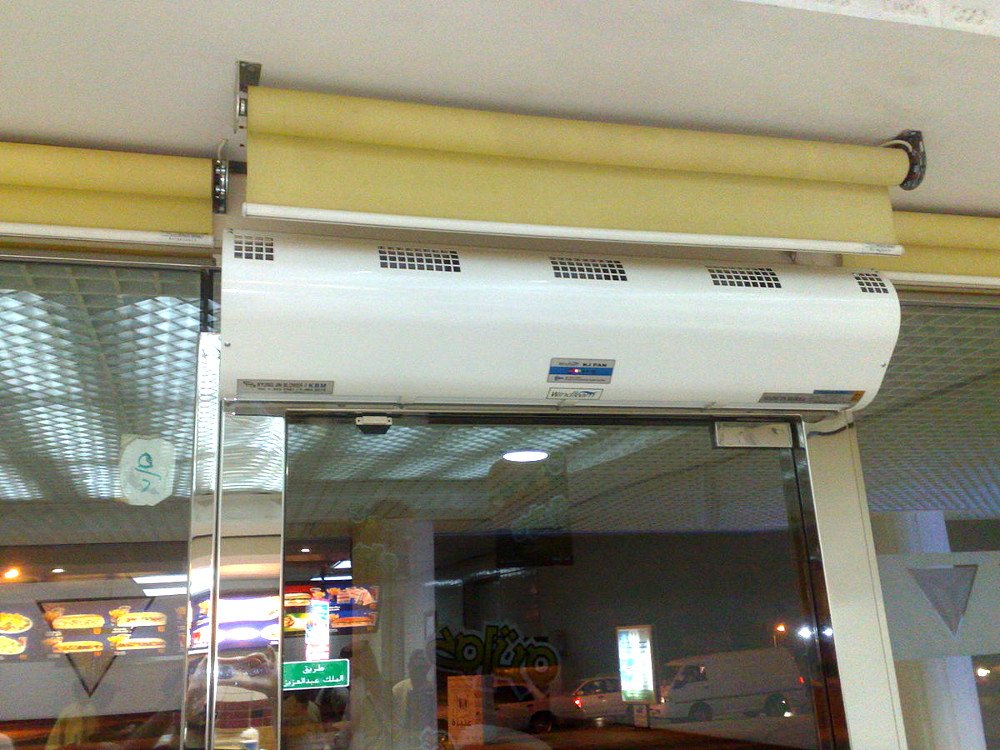
The most common type of air door is a blower fan, usually facing downwards towards the entrance, installed over the entrance of shopping malls, supermarkets, corporate buildings etc.
Note that air doors are not only used over the entrance of the building, but over any opening between two spaces that are conditioned at different temperatures. That’s why you may have noticed that individual shops inside a shopping mall may have blower fans installed in their respective entry points too, so that the ‘mall air’ doesn’t infiltrate into their ‘shop air’.
Advantages Of Air Doors
The primary and the most crucial advantage that an air curtain offers is that it reduces penetration of outside, unconditioned air into a conditioned space by forcing an air stream over the entire entrance.
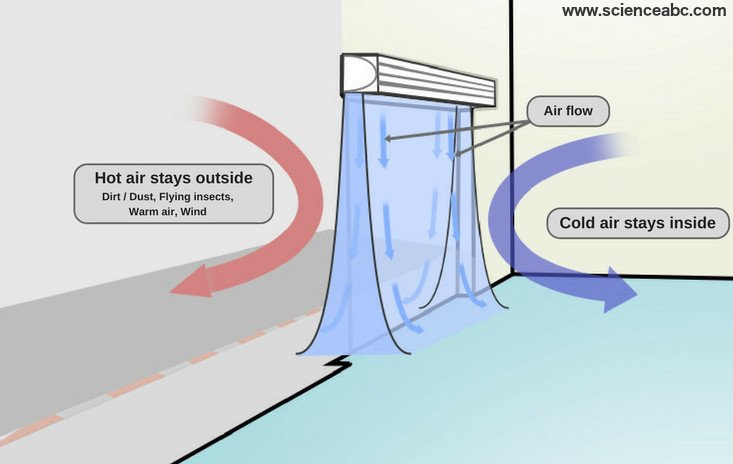
By doing its thing, an air door essentially isolates, to a great extent, the ‘inside climate’ of the building from the outside climate. The effectiveness of an air door, when it comes to preventing infiltration through an entrance, usually ranges from 60% to 80%.
Now you know that the prevention of air filtration through the entrance of a building is mostly related to curbing its electricity consumption. Air doors do a very good job at reducing the electricity bills of these buildings.
However, they do have a couple other advantages too, which have nothing to do with electricity consumption. They also keep dirt and dust from outside from entering the guiding premises. That’s partly why these buildings do not get as dirty as their ‘air door-less’ counterparts. These air barriers can also keep out fumes and unpleasant odors.
Furthermore, air doors also keep numerous bugs from entering the building, thereby indirectly enhancing the comfort of the people inside, at least to some extent.
It’s clear that those ‘feel good’ blower fans at the entrances of malls and supermarkets deserve much more credit than they’re actually given, wouldn’t you say?
References (click to expand)
- N KARLSSON. Air Infiltration through Building Entrances. Chalmers University of Technology
- Open Refrigerator | Physics Van | UIUC. The University of Illinois Urbana-Champaign
- Giráldez, H., Pérez Segarra, C. D., Rodríguez, I., & Oliva, A. (2013, November). Improved semi-analytical method for air curtains prediction. Energy and Buildings. Elsevier BV.
- Younes, C., Shdid, C. A., & Bitsuamlak, G. (2011, October 24). Air infiltration through building envelopes: A review. Journal of Building Physics. SAGE Publications.
- R Upham. Air Leakage Through Automatic Doors - AIVC. Air Infiltration and Ventilation Centre



